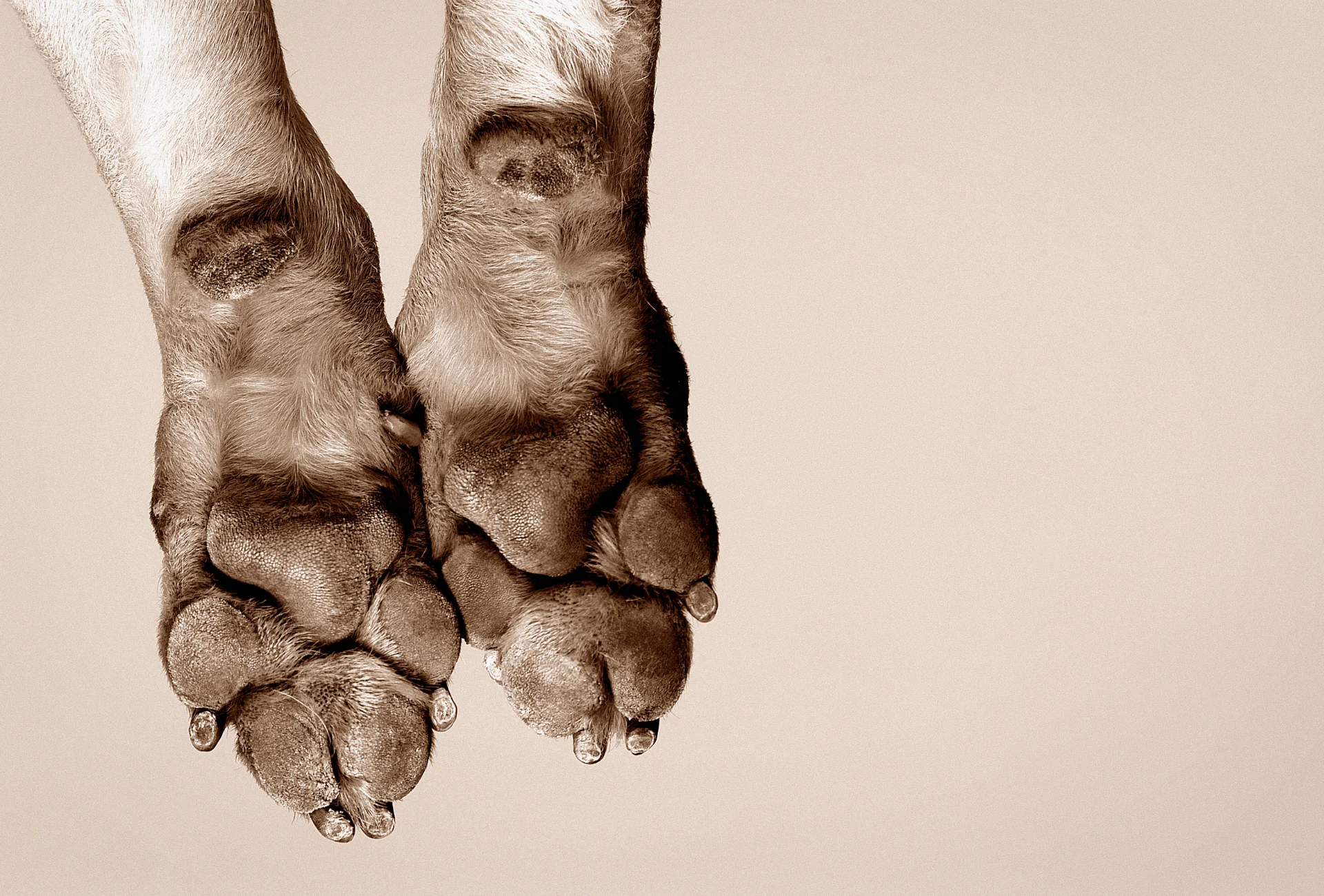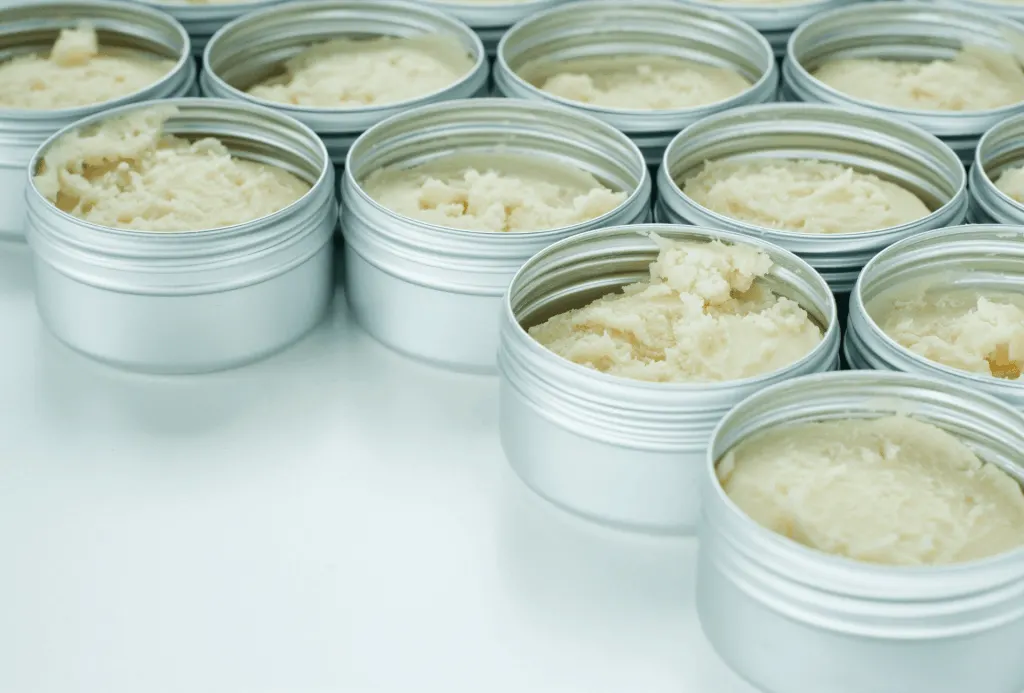You’ve just arrived home from a walk with the pup, or let the furry one inside after a brisk winter potty break.
Your dog is tracking salt inside, depositing it all over the carpeting.
He’s beginning to limp or favor one limb over the others. What could have caused this?
Unlike us, our dogs don’t (usually) wear any kind of boots or shoes on their feet.
Unless they are lying down, those paw pads are in contact 24 hours a day.
Dogs can easily suffer from things like blistered, torn, burnt, or otherwise injured paw pads.
Unless we either provide dog boots or dog paw moisturizer, there is very little protection for those furry feet.
You can either choose one of the dog paw moisturizers mentioned below or you can make your own using my DIY dog paw moisturizer recipe.
How to Moisturize Dog Paws
Cleaning and moisturizing your dog’s paws is important all year round, but especially in winter.
They will collect dirt and other debris no matter what you do, but winter months are exceptional.
We use salt to thaw frozen ice, which can cause quite a few problems if allowed to remain in between those pads.
We also use other chemicals (like antifreeze) on our vehicles, streets, or around our homes.
The right care starts with properly cleaned paws.
At the bottom of this post, I’ve linked you a comprehensive guide on dog paw cleaning and a couple of secrets.
Check your dog’s paw pads on a regular basis.
Carefully spread the pads apart, examining the surfaces, sides, and areas between the pads.
Make a note of any blistering, cracking, swelling, or simple discoloration.
Watch your pup for any signs of discomfort or anxiety.
Signs & symptoms of paw injuries include:
- Biting or chewing paws
- Limping or refusing to bear weight
- Bleeding or bloody tracks
- Whimpering or whining
- Paw pad discoloration
- Cracked or torn nails
Begin to gently massage your chosen moisturizer into the paw pads. We recommend using the Pet Head Oatmeal Natural Paw Butter or the Musher’s Secret Dog Paw Wax.
Petroleum jelly-based moisturizers will help keep your pup’s paws safe and moisturized these winter months (or anytime).
Shea Butter
Shea butter (Not cocoa butter!) will help moisturize your dog’s paws if used topically in small portions.
Shea butter comes from an African tree and is already widely used in human cosmetics.
Best Dog Paw Moisturizers in 2021
After reviewing several products, we’ve listed the top three that are able to provide deep moisturization and the best paw protection with natural ingredients.
100% Natural Vet Formulated Paw Balm
This natural paw wax is the perfect solution for dry and cracked paws.
After application, a moisturizing layer will protect the pads from various environmental hazards, like hot pavement and salt.
The included vitamin E and aloe help nourish the skin and promote tissue healing.
It’s super easy to apply with a creamy consistency and should be left to dry for a couple of minutes.
To prevent residue on your floors, gently dap the paws dry using a paper towel or let them fully absorb the product in boots or socks.
Ingredients: Sunflower Seed Oil, Coconut Oil, White Beeswax, Vegetable Oil, Shea Butter, Carnauba Wax, Candelilla Wax, Vitamin E, and Aloe

Mushers Secret Paw Wax
In addition to protection from heat, snow, ice, or cold damage, Musher’s Secret also advertises their solution for chemical injuries (pesticides, lawn fertilizers).
It’s important to designate between using wax for protection and using it to treat potential injuries.
Ingredients: Blend of 100% natural waxes (White and Yellow Beeswax, Carnauba, and Candelilla Wax) and White & vegetable oils with vitamin E.
Natural Dog Company Paw Soother
Yet another all-natural product, this balm markets itself as ‘vegan’, employing a much wider range of ingredients this time.
Claiming to heal, moisturize, and nourish, Natural Dog Company Paw Soother also treats injured paws or other conditions.
It contains no fragrance, scents, or perfumes and will leave a protective layer on the paw pads that makes them feel smooth and soft.
Ingredients: Mango Butter, Rice Bran Oil, Sunflower Oil, Ylang Ylang Essential Oil, Natural Vitamin E, Carnauba Wax, Rosemary Extract
Dry Dog Paws Home Remedies
Before anything else, carefully trim that excess hair between your dog’s paw pads.
Gently spreading apart those toes, check for anything foreign that shouldn’t be there at all.
Believe it or not, baby wipes offer a safe, quick clean-up option.
You can also opt for pet grooming wipes that are unscented and hypoallergenic.
For those interested in a more complete cleaning, rinse your dog’s paws with ‘lukewarm’ water.
Now, we all know what happens to our wet skin after drying during the winter.
You’re going to have to moisturize those paws, to keep them from drying out further.
Remember to be careful what you use on those dry paws.
Your dog is probably going to feel like anything you apply is strange and foreign, possibly licking it up.
Excessive licking won’t just get rid of the substance you’ve applied, it can cause further drying.
We also want to emphasize the importance of not using anything that might end up in your pet’s mouth/belly and cause harm.
Provide Boots
We go into depth here below, but dog booties will help keep the elements away from those paws in the first place.
They are the safest option to properly protect those sensitive pads from hot pavement or icy temperatures.
Pro Tip: Consider replacing your dog’s booties after you’ve moisturized those dry or cracked paw pads.
This will help keep the moisturizer in place so it can work longer, and prevent your dog from re-drying out those pads through excessive licking.
Oatmeal Paste
Believe it or not, oatmeal paste is another age-old remedy few people actually think about today.
Of course, oatmeal is safe for the dog (we eat it all of the time).
Simply grind down oatmeal, adding a tiny bit of water, until it is a paste.
You can use a ‘thin’ paste on your dog’s paws, but there is no guarantee she won’t just decide to lap it up.
Can I Put Vaseline On My Dog’s Paws?
Though it technically isn’t harmful to your dog’s skin, he can always lick up anything that seems unnatural to those little toes.
You don’t want your dog ingesting too much Vaseline.
If you look at the three recommended products above, none contain Vaseline.
Some sources claim a very small amount of Vaseline to soothe a dog’s paws is ok, but your dog will likely take several trips outdoors each day.
There are better products.
Can I Use Coconut Oil for Cracked Paws?
You can certainly use coconut oil for a dog’s cracked paws.
A bit like shea butter, coconut oil is an all-natural, non-toxic alternative to keep those paws feeling great.
Coconut oil can also create a film, helping to safeguard your dog’s paws from the outside elements.

DIY Dog Paw Moisturizer
Are you looking for a relatively DIY dog paw moisturizer that won’t have you running trips to the store?
You can make this simple solution with ingredients you’ll probably already have at home.
- 2 tbsp coconut oil
- 2 tbsp shea butter
- 2 tbsp beeswax
- 2 tbsp olive oil
For mixing utensils, you’ll need a 4-ounce glass bowl, bamboo skewer, and a 4-ounce wide-mouth container and lid.
- Heat your contents in a microwave for 30 seconds to a minute until the ingredients are melted.
- Stir the contents with a bamboo skewer.
- Add your 20 drops of lavender oils.
- Pour into a glass jar or tin, allowing it to cool.
Once cooled, you can use your fingers to gently massage the balm into your dog’s dry, cracked paws. Make sure to remove any irritants and trim that excess fur first.
What Can Cause Dry Paws?
Imagine you had to walk barefoot over burning asphalt for an hour a day while your owner is protected with some light footwear, oblivious to your discomfort.
Or think of being asked to sprint over miles of terrain, hoping you’re able to clear the occasional shards of glass protruding from a freezing surface.
You don’t have a whole lot of control though; you are tied to the person next to you and can only move around a few inches (other than forward).
In case you’re worried about the heat (as opposed to winter snow), let us provide you with 10 Helpful Summer Safety Tips for Dogs.
If it is winter, you want to take special care when examining your dog’s paws after every single outing.
Extended contact with the type of salt we use to melt ice won’t just stop at drying out your dog’s paws, it could cause chemical burns.
Depending on your breed, chunks of the salty substance can easily collect in between those toe pads and fur.
Pododermatitis
At first, this sounds like a very silly and technical term for a very common problem.
Veterinarians use this crazy word to name simple inflammation of the feet (pod-foot derm-skin itis- inflammation).
Medical terminology is actually pretty simple, once you grasp a few meanings. Now you know what your veterinarian is referring to.
Broken skin, irritation, allergic reactions, or an infection can all lead to swelling and inflammation
According to the Animal Humane Society (and I would agree) dog boots are the best way to protect those paws during winter.
They are even a good idea during summer days when the pavement or sand outside might become extremely hot.
Believe it or not, dog boots have become common use among Alaskan Iditarod mushers.
Most long-distance mushers, in general, use these to protect their dog’s feet.
Many pet owners are starting to use them on their own domesticated pets.
If you want to hear more about this stylish new trend, check out 10 Best Waterproof Dog Boots for Rain/Winter in 2020.
Here are a few things that can cause dry dog paws:
- Harsh chemicals & constant irritation
- Hot pavement
- Paw injuries
- Existing health issues
- Poor nutrition
- Allergies
If you are regularly seeing your dog chewing and nibbling on his paws, take a look at “Why Is My Dog Chewing on His Paws?”.

How to Care for Open Injuries
The methods listed above will help do two things: moisturize dry paw pads and provide a film to protect from outside irritants.
Though they might help with injuries to your pet’s dry, cracked paws, this isn’t the solution you want to take.
If your dog’s pads, or anywhere on the feet, are broken or showing open wounds, they will need to be treated with an antibiotic and bandaged by a veterinarian.
Your veterinarian might recommend you give your dog little socks or boots to wear, to prevent tearing at the bandaging.
Your dog’s skin acts as a barrier against nasty bacteria, viruses, parasites; you name it.
If that barrier no longer exists (especially on feet that contact dirty ground the entire day), your dog could become infected with any number of invaders.
The Bandaging MUST Stay Dry! I know this is going to seem very difficult, especially during the winter.
Damp bandages provide an excellent environment for bacteria to fester, which could turn a minor injury into an extreme situation (has required amputation in select cases).
Being winter, the damp bandaging could also freeze.
“Restrict your dog’s exercise and do not allow the bandage or splint to get wet (Llera, Ryan. DVM).”
VCA Hospitals, Bandage and Splint Care in Dogs
Paw Frostbites
Of course, frostbite is more likely to happen during the winter, and more likely to affect your dog’s paws, tail, ears (extremities).
As your dog’s blood begins to circulate closer to internal organs, in an attempt to keep them warm and the animal alive, those outer tissues can actually freeze.
The tissues can literally freeze, and of course, begin to die. If this happens, rubbing anything on these paws at all can cause more harm.
The faster you get your dog to either a veterinarian or emergency hospital, the more likely that damaged tissue is to be saved.
“In extreme cold or when the body is exposed to cold for long periods, this protective mechanism can reduce blood flow in some areas of the body, especially the extremities (e.g., paws, ears, and tail), to critically low levels (Hunter, Tammy. DVM).”
VCH Hospitals, Frostbite in Dog
If you’re interested in how to clean your dog’s paws properly, just check out the linked article where I explain everything from homemade DIY solutions to easy tricks.
